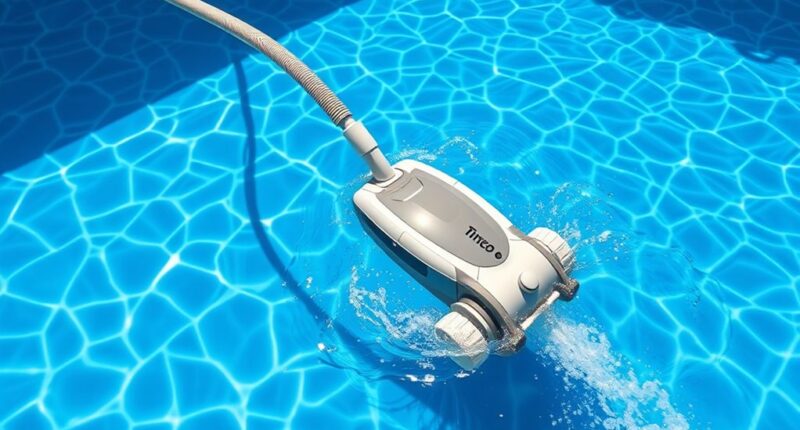Pressure pool cleaners work by harnessing water pressure from your pool’s system to move and scrub surfaces automatically. The cleaner attaches to your return jet or pressure line, and jets or turbines inside generate force to propel it across the pool. As it moves, it collects debris into a filter or bag, while the pool’s filtration system handles clean-up. To see how these components work together for effective cleaning, keep exploring the details.
Key Takeaways
- Pressure pool cleaners use water jets powered by the pool’s existing pressure system to propel themselves across surfaces.
- They connect to a return jet or pressure line, utilizing water flow to generate movement and scrub debris from pool surfaces.
- The cleaners feature rotating brushes or discs that remove dirt while water jets provide the force for navigation.
- Water flow through the system creates suction, pulling debris into a filter or debris bag for easy removal.
- Proper hose connections and regular maintenance ensure optimal water pressure, movement efficiency, and cleaning performance.
The Basic Principles of Pressure Pool Cleaning
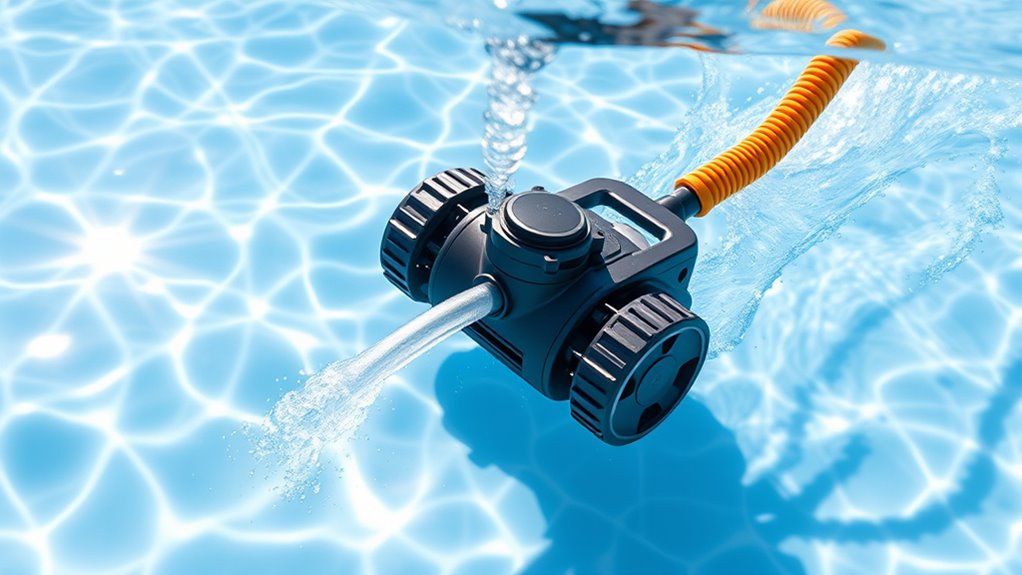
Pressure pool cleaners work by using a powerful jet of water to move themselves around the pool and scrub away dirt and debris. This jet creates the necessary force to propel the cleaner, ensuring thorough coverage of surfaces. Proper pool chemistry is essential for *ideal* cleaning, as balanced chemicals prevent algae buildup and maintain water clarity, making the cleaning process more effective. Additionally, pressure cleaners are designed with energy efficiency in mind; they use water pressure rather than electricity, reducing energy consumption and lowering your utility bills. By harnessing water pressure, these cleaners efficiently remove dirt without relying heavily on electric motors, making them an eco-friendly choice. The effectiveness of pressure pool cleaners also depends on correct installation, ensuring optimal water flow and cleaning performance. Ensuring proper water flow is crucial for maximizing cleaning efficiency and coverage. Regular maintenance of filter systems can further enhance their performance and longevity. Understanding these basic principles helps you maximize your pressure pool cleaner’s performance and keep your pool sparkling clean. Moreover, advancements in AI-driven technology are beginning to optimize the operation of pool cleaning systems, leading to smarter and more efficient cleaning cycles. For example, incorporating sensor technology can help the cleaner detect areas with more debris and focus cleaning efforts accordingly.
Key Components of a Pressure Pool Cleaner
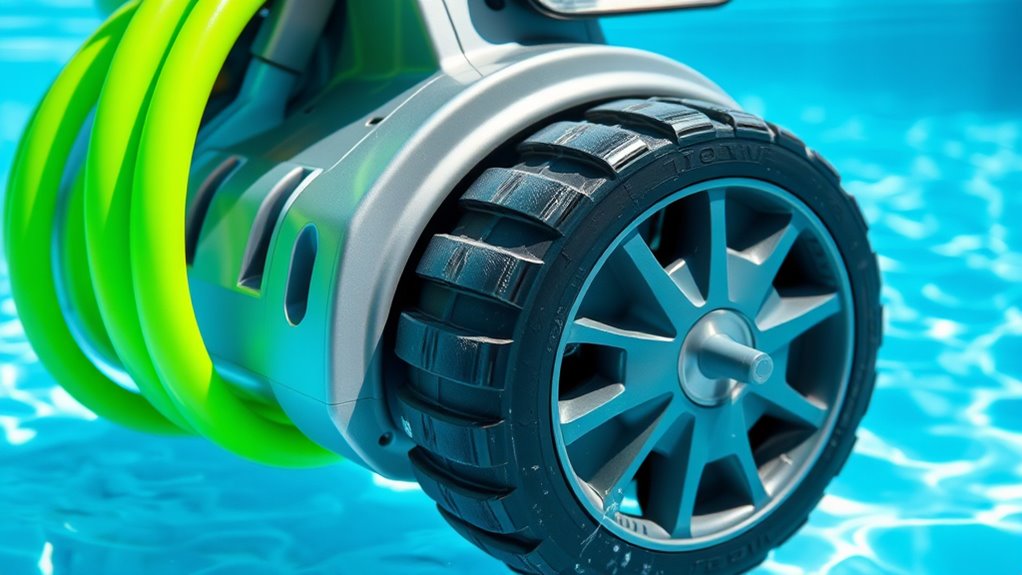
What are the essential parts that make a pressure pool cleaner work effectively? The key components include a powerful motor, a flexible hose system, a rotating brush or disc, an inlet valve, and a filter or debris bag. These parts work together to guarantee proper cleaning while maintaining pool safety tips. For peak performance, you should regularly check the pool chemical balance, as imbalanced chemicals can hinder the cleaner’s efficiency. Properly securing the hose prevents leaks, and cleaning the filter keeps debris from clogging the system. Additionally, understanding the automation technologies involved can help optimize maintenance routines. Regularly practicing mindfulness and ensuring adequate sleep can enhance your focus and prolong the effectiveness of your cleaning routine. Maintaining the component functionality and following pool safety tips helps avoid damage and ensures safe operation. Being aware of AI detection methods can also be useful for identifying issues with electronic components in modern pool cleaning systems. Understanding these components helps you troubleshoot issues and keep your pool spotless with ease. Incorporating proper maintenance practices can further extend the lifespan of your pressure cleaner and improve its performance.
How Water Pressure Powers the Cleaner

Water pressure is the driving force that powers a pressure pool cleaner, enabling it to navigate and scrub the pool surfaces effectively. As water flows through the cleaner, it creates the necessary force to move the device along the pool walls and floor. The cleaner’s jets and turbines harness this pressure, allowing it to reach all areas of your pool. Proper chlorine levels and pool temperature can influence how well the cleaner performs; if chlorine is too high or the water is too warm, buildup may occur, affecting water flow and pressure. Maintaining ideal chlorine levels and temperature ensures consistent water pressure, helping your pressure cleaner operate efficiently. This balance keeps the cleaner moving smoothly, maximizing cleaning coverage and prolonging its lifespan. Additionally, understanding the importance of indoor air quality can help in maintaining a healthier environment around your pool area. Proper water circulation is essential for preventing debris buildup and ensuring optimal cleaner performance. Regularly checking water flow rates can also help identify potential issues early and maintain optimal cleaning efficiency.
The Role of the Pool’s Filtration System
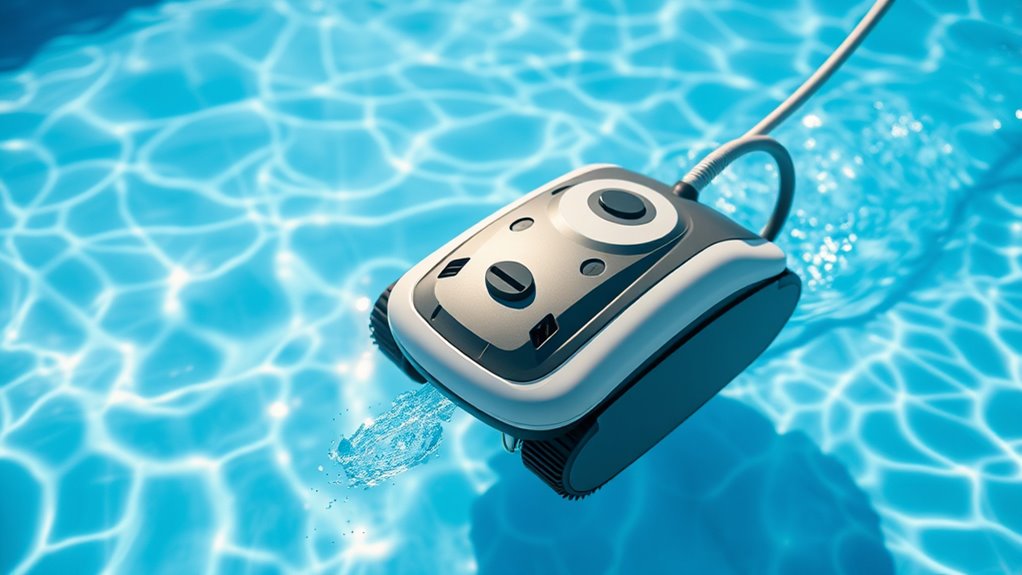
The pool’s filtration system plays a crucial role in maintaining ideal water flow and cleanliness, which directly impacts your pressure pool cleaner’s performance. Proper filtration ensures debris removal, keeps water clear, and supports effective pool maintenance. When your filtration system functions well, your cleaner can operate efficiently, reducing the need for manual cleaning. To optimize performance, regularly check and clean the filters, maintain proper chemical balance, and ensure water circulation is steady. A balanced chemical environment prevents algae growth and bacteria buildup, making the filtration process more effective. Additionally, understanding how GMC tuning techniques can enhance engine and system performance underscores the importance of a well-maintained filtration system. Without a well-maintained system, debris can clog the cleaner, and water quality can decline. Regular upkeep of your pool’s filtration system guarantees smooth operation and long-lasting cleaner efficiency. Proper filter maintenance is essential to keep your system running at peak performance and extend the lifespan of your pressure cleaner.
Movement Mechanics of the Cleaner
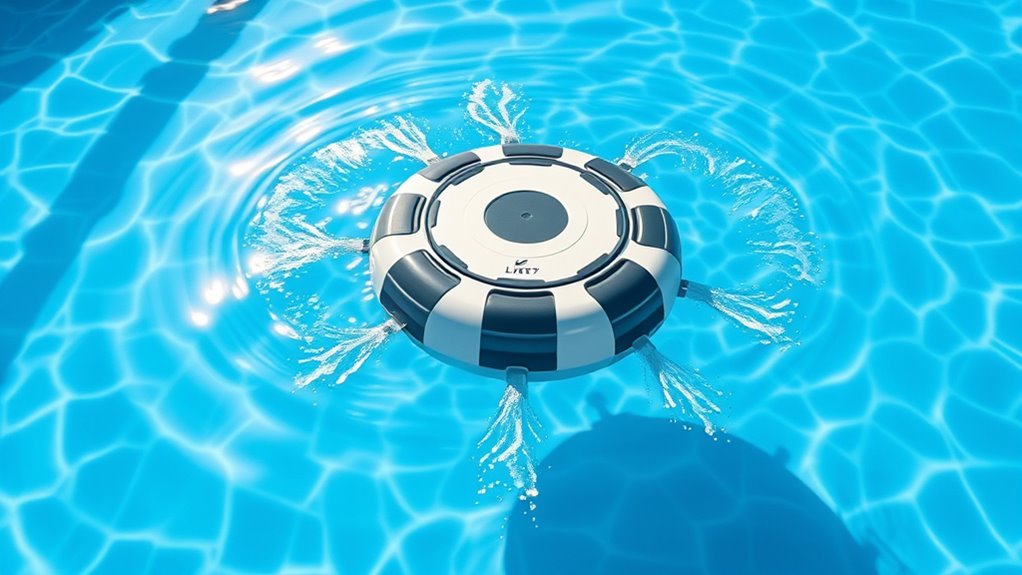
The way your pressure pool cleaner moves depends on how water pressure powers its motion and how its movement pattern is designed. These factors determine how effectively it covers the pool surface. Understanding these mechanics helps you choose a cleaner that works best for your pool’s shape and size. Additionally, the type of paint sprayer and its settings can influence the efficiency and coverage of your painting project. By examining the movement mechanics of the cleaner, you can better assess its suitability for different pool configurations and ensure optimal cleaning performance.
Water Pressure Power
Have you ever wondered how pressure pool cleaners maneuver so effectively across the pool floor? It all comes down to water pressure power. These cleaners use high-pressure water jets to propel themselves, allowing them to move smoothly and cover large areas efficiently. As water flows through the hose, it creates a force that drives the cleaner forward, ensuring thorough cleaning. This method promotes chemical safety by reducing the need for harsh chemicals and enhances energy efficiency since it relies on existing water pressure rather than motors. To optimize performance, consider these factors:
- Proper hose connections
- Consistent water flow
- Regular maintenance
- Correct pressure settings
- Minimizing obstructions
This combination ensures your cleaner works effectively while conserving energy. Additionally, understanding Kia Tuning techniques can help you optimize the performance of your equipment. Moreover, utilizing Mazda Tuning strategies can further enhance your pool cleaning system’s efficiency and longevity. Proper pressure regulation is crucial for maintaining optimal cleaning performance and preventing damage to your equipment. Being aware of skincare innovations can also help you choose the best equipment that aligns with your maintenance routines. Regularly assessing and adjusting your system based on vertical storage solutions can also contribute to a more organized and efficient pool area.
Movement Pattern Design
Movement pattern design determines how your pressure pool cleaner navigates the pool surface. Robotic navigation systems help the cleaner move efficiently, ensuring every area gets cleaned. Pattern optimization is key; the cleaner follows a specific route to cover the entire pool without missing spots or wasting time. Some cleaners use randomized movements, while others follow programmed paths based on pool size and shape. Advanced models analyze the pool layout to improve navigation, reducing overlap and ensuring thorough coverage. Proper movement pattern design prevents the cleaner from getting stuck or missing dirt. By combining robotic navigation with pattern optimization, the pressure cleaner works smarter, not harder, making your pool cleaning faster and more effective. Incorporating navigation features can further enhance the efficiency and coverage of your pool cleaner. Additionally, sensor technology allows the cleaner to adapt to obstacles and changing pool conditions, further optimizing its movement.
The Suction and Debris Collection Process
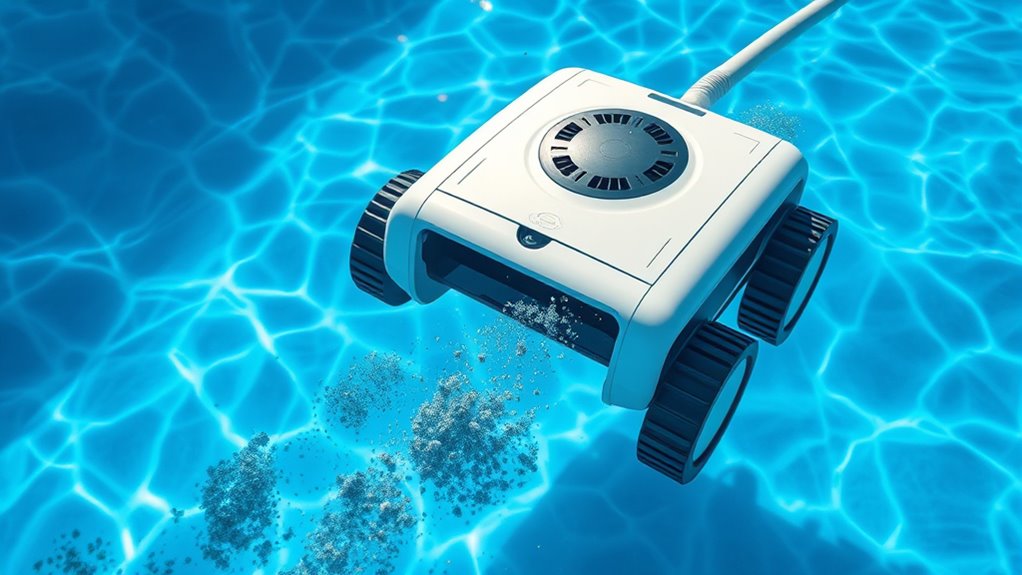
Pressure pool cleaners use powerful suction to efficiently lift debris from the pool’s surface and bottom. As water flows through the cleaner, it creates a strong vacuum that pulls in leaves, dirt, and other debris. This debris is then directed into a filtration bag or chamber for easy removal. The suction system guarantees consistent debris removal, even from hard-to-reach corners. You’ll notice that the cleaner’s water flow is maximized to maximize debris collection without disturbing the pool’s surface too much. Regularly checking and emptying the debris chamber keeps the process efficient. Additionally, proper water flow management is essential for optimizing debris removal and preventing clogs. Effective water flow management for ideal debris removal. Suction power adjusts based on debris load. Debris is captured in a durable bag or chamber. Minimizes manual cleaning efforts. Keeps your pool crystal clear and inviting.
Types of Pressure Pool Cleaners and Their Differences
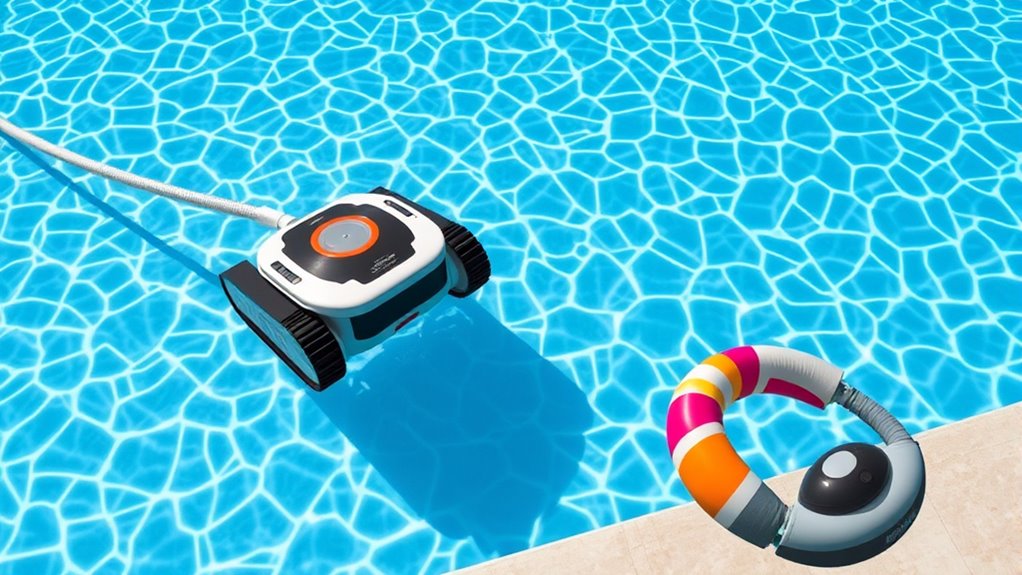
There are several types of pressure pool cleaners, each designed to suit different pool sizes and cleaning needs. Some models are robotic, using onboard motors to navigate and scrub surfaces, making them ideal for thorough pool maintenance. Others are traditional booster pump cleaners that connect directly to your pool’s existing pressure system, offering reliable cleaning with durable equipment. You might also find combination cleaners, which blend features of both, providing flexibility for various pools. The key differences lie in their equipment durability and cleaning efficiency. Robotic cleaners tend to be more durable and low-maintenance, while booster pump models are often more cost-effective but may require more upkeep. Choosing the right type depends on your pool size, debris load, and long-term maintenance preferences.
Installing and Operating a Pressure Pool Cleaner
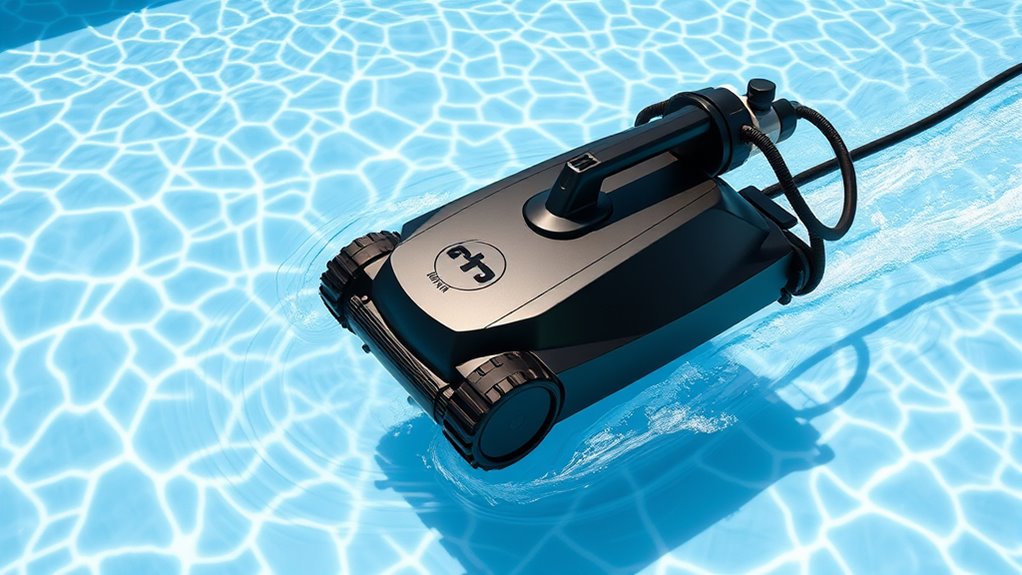
Installing and operating a pressure pool cleaner is straightforward when you follow the proper steps. First, verify your pool’s chemical balance is ideal to prevent damage and improve cleaning efficiency. Next, connect the cleaner to your pool’s return jet or dedicated pressure line. Make sure the hoses are securely attached and free of kinks for maximum energy efficiency. Turn on your pool pump and observe the cleaner’s movement, adjusting the flow rate if necessary. Regularly check and clean the filter to maintain excellent performance. Keep an eye on the cleaner’s operation to spot any issues early. Proper installation and operation help maintain clean water, reduce energy use, and prolong your cleaner’s lifespan.
Proper setup ensures optimal cleaning, energy efficiency, and longer lifespan for your pressure pool cleaner.
- Verify chemical balance before installation
- Attach hoses securely to prevent leaks
- Adjust flow for excellent cleaning
- Regularly clean filters for efficiency
- Monitor operation for troubleshooting
Benefits and Considerations of Using Pressure Pool Cleaners
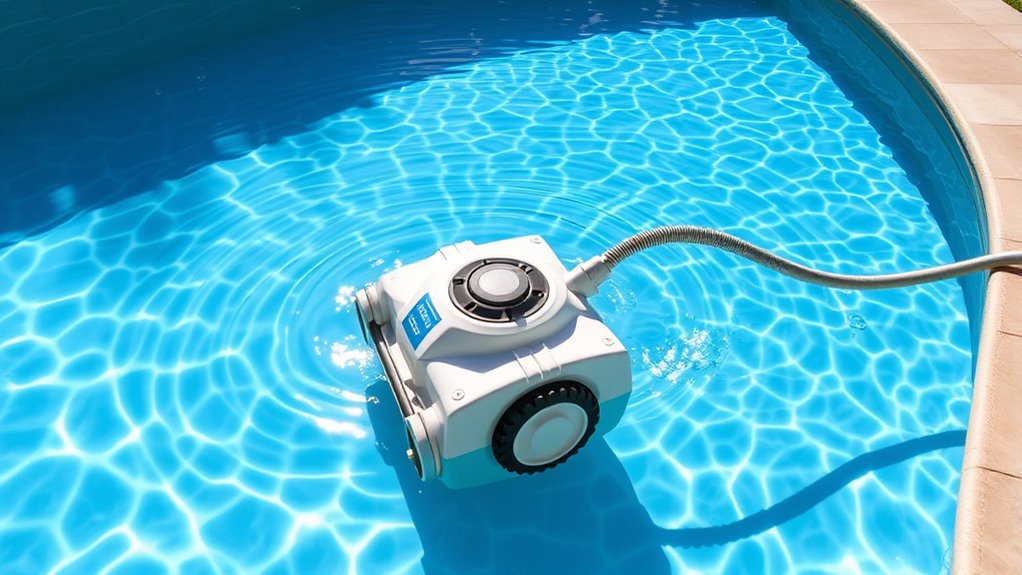
Using a pressure pool cleaner offers several notable benefits that can make maintaining your pool easier and more efficient. One key advantage is improved pool maintenance, as these cleaners thoroughly scrub and remove debris from hard-to-reach spots. They’re also energy efficient, utilizing existing pool pressure to operate without needing extra power sources, which can lower your energy bills. However, consider that pressure cleaners may require proper setup and regular maintenance to function most effectively. They might not be suitable for pools with delicate liners or complex shapes, and their effectiveness depends on your pool’s plumbing system. Overall, pressure pool cleaners can save you time and effort, making routine cleaning simpler while promoting energy-efficient pool upkeep.
Frequently Asked Questions
How Often Should I Service My Pressure Pool Cleaner?
You should service your pressure pool cleaner regularly to keep it functioning efficiently. Follow your pool’s maintenance and cleaning schedules, ideally inspecting and cleaning the filters and hoses weekly or bi-weekly. Regular maintenance prevents clogs and wear, extending the cleaner’s lifespan. Adjust your service frequency based on usage and pool conditions, ensuring it operates smoothly and keeps your pool sparkling clean. Proper upkeep saves you time and effort in pool maintenance.
Can Pressure Pool Cleaners Handle Large Debris Effectively?
You might worry that pressure pool cleaners can’t handle large debris, but they actually excel in debris filtration. Their powerful motors are built for durability, ensuring they can tackle bigger leaves and twigs without breaking down. With proper maintenance, these cleaners efficiently filter out large debris, keeping your pool spotless. So, rest assured—you’ll find they’re a reliable choice for managing substantial debris in your pool.
Are Pressure Pool Cleaners Compatible With All Pool Types?
You’ll find that pressure pool cleaners are compatible with most pool types, including vinyl, concrete, and fiberglass surfaces. They efficiently clean the pool surface and collect debris, making maintenance easier. However, some models work better with specific surfaces or require adjustments for ideal debris collection. Always check your cleaner’s specifications to confirm it suits your pool type, guaranteeing effective cleaning without damaging the pool surface.
What Maintenance Is Required for Optimal Performance?
Think of your pressure pool cleaner as a car needing regular tune-ups. You should regularly check and clean the filter to keep debris from clogging the system. Inspect nozzles for wear and proper alignment, replacing them if needed. Keep hoses free of kinks and secure connections tight. Routine filter maintenance and nozzle inspection guarantee your cleaner runs smoothly, so your pool stays spotless and inviting with less effort.
Do Pressure Cleaners Work Well in Saltwater Pools?
You’ll find that pressure pool cleaners can work well in saltwater pools if they’re saltwater compatible. Look for models with corrosion resistance to prevent damage from the salty environment. Regular maintenance and rinsing help extend their lifespan. Since saltwater can be tougher on equipment, choosing a cleaner specifically designed for saltwater pools guarantees better performance and durability, giving you a cleaner pool with less hassle.
Conclusion
So, now you know how pressure pool cleaners work—thanks to water pressure and a bit of clever engineering. Who knew cleaning a pool could be so high-tech? With these machines doing all the dirty work, you can finally relax poolside without lifting a finger. Just sit back, enjoy the sparkling water, and marvel at how your pool’s new best friend makes maintenance almost too easy—almost. Cheers to effortless cleaning, or so they say!
